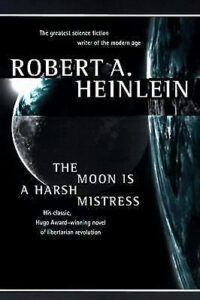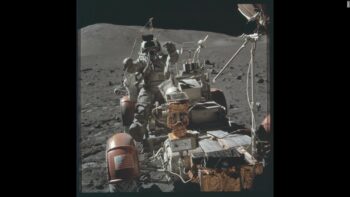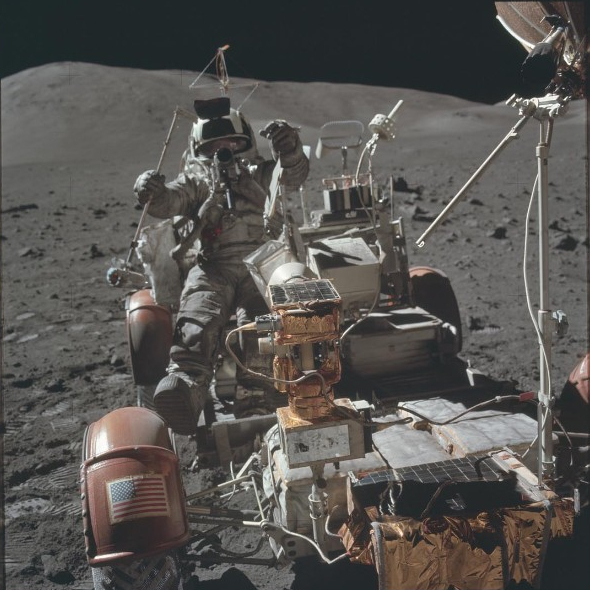Settling the Solar System in Science Fiction, part 3: the Moon
The Moon, which Genesis describes as “the light to rule over the night,” has in fact been the subject of a great deal of science fiction. Though much of the science fiction dedicated to Earth’s moon describes exploring it or traveling to it, rather than settling it. Still, enough tales have been set there and it is so near to Earth, relatively speaking, that we ought to treat the prospect of settling on the Moon seriously. Though it may have more potential as a military base or scientific station than a permanent human settlement, if given the opportunity, human beings will consider settling on the Moon. And science fiction has already considered it.
What’s the Moon Got for Survival?
(For a review of what humans need to survive in space, please see the section on Human Survival Needs in part 1 of this series.)
Oxygen, Energy, Water
You might think the Moon has nothing much, but in fact it has plenty of oxygen in oxides found in lunar rocks. It also has plenty of energy for food production and warmth–solar panels would work very well there. And, in addition to those two things, the Moon has water. Not just water trapped in craters that never receive sunlight at the lunar north and south poles–a 2020 report revealed there’s a surprisingly high amount of water on the sunlight side of the lunar surface. Water trapped in the microscopic glass bubbles common on the Moon or within grains of sand. Plus, the same article I just linked also reveals there’s probably even more craters with water ice in them than believed in the past. Plenty of water for a small colony.
Resources
I’m going to deviate from the order of the Mercury (part 1) post because I’d like to say the most important thing about the Moon at the end of this section. In the meantime, the Moon has plenty of mineral resources…but isn’t all that great in that regard. Much of the Moon seems to be undifferentiated material–that is, from what is known so far about it, it has no ores (Mercury probably has ores). Mining the lunar surface would seem to require scooping up a lot of moondust and running it through some kind of furnace that would superheat materials and allow separation into various chemical elements. A process that’s more difficult that processing materials on Earth, but which lunar settlers could pull off, given enough energy and the right equipment. Though we should note that unlike Venus or Earth, the Moon doesn’t have much easily-available carbon.
Protection
The lunar surface doesn’t offer any protection from radiation or meteors at all, except when incoming radiation or meteors are directed at the far side of the Moon, but digging underground would work there. It’s not known if the Moon has any natural underground caves–certainly it doesn’t have any created by water, but may not have any created by vulcanism, either. The other requirements for protection would have to be manufactured, though moondust could become the basis for creating soils that would be part of processing and eliminating waste. But the most important bit that requires humans to live on planets as opposed to deep space may be inadequate on the Moon: Gravity. With gravity at 1/6th of Earth (or 16%), the gravity on the lunar surface may prove to be insufficient to prevent destructive bone loss and malformation of human embryos–though on the other hand, it might be fine. Nobody knows. But there’s a separate issue concerning lunar gravity.
Gravity
The greatest thing about the Moon as a place humans could settle is also the worse thing–its gravity is much lower than Earth’s. While humans living there run the risk of bone loss and other medical problems, the lower gravity means if you wanted to build spacecraft or stations out of lunar materials to use in deep space, it would cost much less fuel to get those materials or pre-constructed craft in orbit from the Moon than it would from Earth. The difference in fuel needs is so extreme that it likely would easily make up for the extra costs of manufacturing on the Moon. So the Moon could be an excellent production center or military base–which might mean the Moon would do very well in the category of “protection from attack.”
How Has Science Fiction Seen the Moon?
There’s a tremendous diversity of stories that mention or feature Earth’s Moon. Such tales are not always clearly science fiction–literary fiction and fables have also featured voyages to the Moon. Although Wikipedia is not a perfect source in general, I’m finding its articles on planetary bodies in fiction to be very helpful. Please refer to the “Moon in fiction” Wikipedia article for more detail on what I’m summarizing below.
First Voyages
A tremendous amount of fiction concerning the Moon has simply imagined what it would be like to travel there for the first time, obviously produced prior to the 1969 Apollo 11 mission, the first actual landing. These include Lucian of the Second Century AD writing satire that features the Moon, a story by Johannes Kepler, another by Francis Godwin (which featured a Spaniard using a chariot pulled by geese), a tale by Cyrano de Bergerac, Daniel Defoe, Edgar Allen Poe, Jules Verne, H.G. Wells, Isaac Asimov (in 1939), Robert A. Heinlein (who consulted on the script of a 1950 movie on the subject), and Arthur C. Clarke (in 1951).
Fantastic Adventures on the Moon
While stories about the first trips to the Moon described it as inhabited as often as not, the point of such stories was not the interaction with Moon people as much as the exploration itself. But other tales showed it to be a fantastical, even magical place. And set various stories there, where heroes have adventures of a wide variety of types–or alternatively, feature Moon people coming to Planet Earth. These stories include a 10th Century Japanese folktale, an Italian epic poem (Orlando Furioso), Pan Twardowski in Polish folklore, a story by Hans Christian Anderson, and even a tale by J.R.R. Tolkien, Such stories mostly came to an end after the Apollo missions found a desolate, empty Moon, but there are some modern examples nonetheless, such as David Almond’s The Boy Who Climbed Into the Moon.
A Future Moon That’s Been Colonized
A large number of science fiction stories have imagined a future Moon that has colonies, often in the context of talking about other developments in outer space–so a story many mention or feature lunar colonies, but also talk about more numerous and important colonies on Mars or elsewhere. These stories include about a dozen stories from Robert A. Heinlein, several of which I will talk about in more detail under the next point. Also included are four novels from Arthur C. Clarke, Ursula K. Le Guin’s Lathe of Heaven, Isaac Asimov’s The Gods Themselves, G.R.R. Martin’s Dark, Dark Were the Tunnels, Kim Stanley Robinson’s The Lunatics, Pierce Brown’s Red Rising series, Artemis by Andy Weir (of The Martian fame), and numerous references to an inhabited Moon in the Star Trek universe (among many other stories).
The Moon as a Military Threat to Earth
While the Moon has been very popular in terms of a place to imagine future colonies, science fiction at times has portrayed it as hostile to the Earth. That’s even though sci fi has much preferred Mars as a source of aliens interested in invading Planet Earth, but at least once the Moon provided invaders of our planet in fiction–though more often aliens hostile to us, though not invaders. Or, alternatively, humans inhabiting the Moon who represented a threat to people living on Earth.
Alien Invaders From the Moon / Hostile Aliens on the Moon
These stories include an 1809 essay with story elements by Washington Irving, which openly compared lunar invaders to what Europeans did to American Indians. Tales of hostile Moon aliens (though not invading Earth) include the greatest early science fiction series in Polish, The Lunar Trilogy by Jerzy Żuławski (written 1901-11) , which imagined the descendants of the first human explorers of the Moon becoming slaves of malicious lunar aliens. Likewise, C.S. Lewis’s That Hideous Strength refers to the near side of the Moon having evil aliens the scientists of N.I.C.E. admired–while the far side had creatures the eugenicist aliens from the near side persecuted. And the very-low-rated 2013 film Stranded featured a shapeshifting alien on the Moon attacking a human lunar base.
Hostile Humans Threatening the Earth from the Moon
Perhaps more significantly than menacing aliens on the Moon, science fiction has shown humans inhabiting the Moon threatening the Earth. These tales include the 1925 novel Menace from the Moon, which imagined that humans had arrived the lunar surface in the 1600s and now were in a crisis and were attacking Earth with a heat ray. In a way more technologically realtistic, Robert A. Heinlein’s Rocket Ship Galileo, in which teenage prodigies in a rocket club help a scientist convert a suborbital rocket into a moonship, features a Nazi base on the Moon. In the story, the Nazis landed there during WWII, bent on developing a weapon to allow the Third Reich to rise again. (Note this 1947 novel was the first sci fi novel Heinlein ever wrote–and the first sci fi novel I ever read). A 2012 Finnish film Iron Sky likewise featured lunar Nazis–and an Austin Powers film featured Dr. Evil pointing a laser at Washington D.C. from the surface of the Moon. However, there’s one novel about the humans on the Moon that stands apart from the rest in describing what humans living there could do to Earth.
The Moon is A Harsh Mistress
Robert A. Heinlein’s 1966 novel The Moon is a Harsh Mistress describes a lunar society that declares its independence from the Earth. Earth had colonized the Moon in the story, including setting up penal colonies, but also funded the building of lunar mines. The mines launched their ore back to Earth with a giant electromagnetically-powered launcher, a piece of technology commonly known as a railgun. When the lunar colonists decided to declare their independence from Earth, they used the launcher to hurl lunar rocks at Planet Earth. Instead of destroying cities, which they easily could have done, they aimed at locations on Earth that allowed them to demonstrate their capacity to kill–mostly targeting the open ocean outside of a major city, warning the “Earthlings” an attack was coming to allow for evacutation. Then sending a tsunami wave at the targeted city as a body consisting of tons of moon rocks slammed into the Earth.

Copyright: Robert A. and Virginia Heinlein Prize Trust
Heinlein’s tale included him heaping praise on Libertarian economics coupled with enthusiasm for combat (Heinlein also wrote the novel Starship Troopers) plus featured a central Artificial Intelligence running lunar systems as a key member of the rebellion against Earth–all thought-provoking stuff. But what most distinguished the story was its use of relatively simple ideas, especially the potential the Moon has to attack Earth. Because the Earth has much higher gravity than the Moon, it has an enormous military advantage against the Earth. Launching rocks from there with an electromagnetic gun requires nothing more than building such a system, abundant lunar solar power, and abundant lunar rock. Getting the rocks off the lunar surface is relatively easy due to the its light gravity and lack of atmosphere, but the Earth’s heavy gravity guarantees that any body of rock large enough to successfully pass through Earth’s atmosphere will impact with a force equivalent to a nuclear weapon.
It’s like the Moon is on a high castle wall over the Earth. A lunar defender has to lift a rock over the ledge of the wall (i.e. launch it from the Moon), but from there, the rock falls on its own, doing tremendous damage to enemies below by the force of gravity alone. The Moon in fact provides an ideal base to build relatively low-tech weapons which would seriously menace Planet Earth.
What’s Unique About the Moon–Military Advantage And Space Telescopes
Close
As I mentioned in the section above, the Moon would be a great place to launch weapons at the Earth. I’ll say more about that in a bit, but part of the reason why that’s a menace to Earth is because the Earth and Moon are much closer to one another than any other significant astronomical body comes to Earth. The proximity of the Moon relative to even Venus or Mars is what makes it such a likely place for human activity. Such activity would likely include tourism, which in fact has been mentioned by numerous science fiction stories, even though I didn’t focus on that above.

Edgar Mitchell of Apollo 14 on the Moon. Credit: NASA
Low Gravity
The Moon’s low gravity is its double-edged sword so to speak. On the one hand, it means anything built there will be much easier to get into space. It’s got real potential as a place to manufacture spacecraft (though if Mercury has separated ores, Mercury might be better than the Moon for building spacecraft and as good at launching the craft from its surface with a rail gun). On the other hand, it may mean humans living on the lunar surface lose too much bone over time to make permanent lunar colonies impractical. (Only time and further experimentation will tell on the bone loss and embryo development issues low gravity worlds may pose human beings).
Military Advantage
As mentioned above, the Moon is a great place to build a base to attack Planet Earth. It also could be used to defend Earth, though the fact it is on only one side of Earth at a time means it could not defend against ships coming from all directions, meaning the Moon by itself would be insufficient for the defense of Earth (but could be a key part). But the Moon’s low gravity means it could be used to launch missiles and other smart weapons (as opposed to “dumb” heaps of rock). The Moon’s lack of atmosphere means beam weapons built on the lunar surface could easily shoot into space without pesky air, with variable optical qualities, getting in the way.
Outer Space Treaty Limitations
Since the Moon is such a great place to build military bases and since the weapons on those bases could be so potentially dangerous to Earth, nations of the Earth have seen the Moon and outer space in general as representing great potential danger to life on Earth. For that reason most nations have signed an Outer Space Treaty, promising not to put nuclear weapons in space and to in general use space for peaceful purposes. Note that the Outer Space Treaty was negotiated in 1966 and signed in 1967–after Heilein’s publication of The Moon is a Harsh Mistress in 1966, which pointed out the military potential of the Moon. Science fiction does have the potential to influence public policy.
The deliberate de-militarization of space means the nations of the world will also not look kindly on space settlements building space weapons of any kind or declaring their political independence of already-existing nations. These political considerations may in fact keep the Moon from being used for its most obvious purpose as a military base. But the Moon has one more natural advantage worthy of consideration.
The Moon as an Astronomy Station
Because the Moon has no atmosphere and because its far side has over 2,000 miles (near 3,500 km) of rock separating it from Earth, radio signals from Earth that interfere with radio telescopes would fall silent on the moon’s far side. Also there would be no issue for light pollution for optical telescopes. So the Moon, specifically the far side, would be a great place to build a series of telescopes, primarily radio but also optical, exploring the depths of outer space.
Conclusion
Because the Moon is not as friendly to life as other planets seem to be, it remains an afterthought in plans to colonize the Solar System, even though a great deal of science fiction has imagined it as at least partially inhabited. The Moon in fact would be a great place to build bases to create spacecraft and provide for military defense of Earth–if, that is, humans could be persuaded to unify to defend Earth rather than attack it. And of course, the lunar far side would be the greatest place to set up astronomical instruments, including telescopes, especially radio telescopes.
Could you imagine yourself living on the Moon? Or going there as a tourist?
Had you ever considered the Moon’s potential as a military base before? Do you think the Outer Space Treaty is wise to prevent humans from building military bases in space?
Do you have any other thoughts you’d like to share? Please make your thoughts known in the comments below.










































Lately I haven’t thought as much about people settling the moon itself, especially not for military purposes, but it does make sense.
The concerns with having a weapon in our orbit(even one that’s supposed to protect us) were kinda talked about in the Young Justice animated series as well, if I recall correctly. Like, there was some debate over the fact that the Justice League had their big meeting place/space station thing up in orbit where it could easily fire its lasers at earth. Of course the Justice League built it to help counter threats from space and stated that much, but understandably there was still a lot of mistrust toward them.
The Outer Space Treaty sounds like a very good idea for now, but we’ll see how long it lasts. Considering the way people tend to be, the treaty will probably get violated, altered, or even gotten rid of as space exploration, travel, etc becomes commonplace. That would be especially true if future spacefaring civilizations of humans became estranged from us or we discovered hostile aliens. At that point, our fears would likely turn much more outward and shift our priorities accordingly.
I’ve sorta seen the moon mainly a place for research and a bit of a trial run for space exploration and settlement. Since it’s pretty much the closest thing to us, we could potentially help any moon colony if it happened to be in trouble. Or, at the very least, its settlers would have a chance to evacuate to earth if something went wrong. So in a lot of ways it’s a good first step in terms of learning how to handle certain conditions of space settlement.
I’m really enjoying this whole series. Thank you.
Mary Robinette Kowal’s latest entry in her Lady Astronaut series, The Relentless Moon, is focused on the colonization of the Moon as part of her larger world of an alternate history of the space program and is very good. Her research and imagination made me think about the technology of colonization in ways I hadn’t before.
I’ve often thought that I’d have loved to be a moon or Mars colonist, born in another time. I hope that my grandchildren will see the time when we have science bases on both. I think the idea of astronomical observatories based on the far side is exciting.